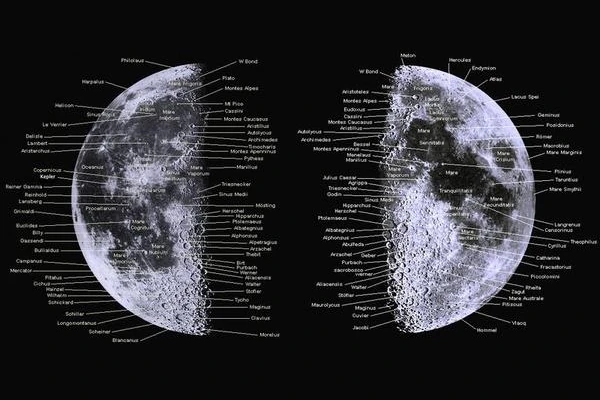
Lunar craters are mainly the result of meteorite and asteroid impacts. Their size ranges from a few meters to several hundred kilometers. The initial depth of a crater can be estimated by the relation \( d \approx 0.2 \times D \) where \(D\) is the diameter of the crater. Studying their erosion and superposition allows estimating their relative age and reconstructing the history of Solar System bombardments.
Lunar craters are classified according to several criteria: simple or complex, presence of central peaks, concentric rings, and their geological age. This information provides clues about the Moon's internal activity and the evolution of its mantle.
| Crater type | Diameter (km) | Main characteristic | Famous example |
|---|---|---|---|
| Simple | 1 to 15 | Smooth walls, flat bottom | Bell Crater |
| Complex | 15 to 200 | Central peaks, terraces on the walls | Tycho |
| Multi-ring | 200+ | Concentric rings, often low bottom | Orientale |
The combined analysis of their morphology, degree of erosion, and crater superposition allows estimating their relative age and reconstructing the chronology of bombardments. The precise coordinates and characteristics of the main craters, such as their diameter and the presence of central peaks, are references for lunar mapping and the calibration of impact dynamics models.
| Crater name | Diameter (km) | Type | Notable feature | Latitude | Longitude |
|---|---|---|---|---|---|
| Tycho | 85 | Complex | Very marked central peak, extended rays | -43.3° | -11.2° |
| Copernicus | 93 | Complex | Terraces on the walls and central peak | 9.7° | -20.1° |
| Kepler | 32 | Complex | Very visible bright rays | 8.1° | -38.0° |
| Aristarchus | 40 | Complex | Brightest area on the Moon | 23.7° | -47.4° |
| Clavius | 225 | Complex | Concentric rings and secondary craters | -58.4° | -14.4° |
| Plato | 101 | Complex | Flat and dark bottom, steep walls | 51.6° | -9.3° |
| Schrödinger | 312 | Multi-ring | Concentric rings and complex central peak | -75.0° | 132.5° |
| Orientale | 930 | Multi-ring | Large basin with several concentric rings | -20.0° | 95.0° |
| Langrenus | 132 | Complex | Central peak and terraces on the walls | -8.9° | 61.0° |
| Gassendi | 110 | Complex | Presence of rilles and central peak | 17.6° | -39.9° |